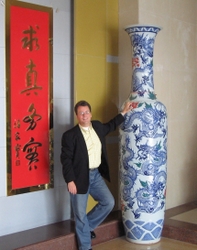Good reasons

Porcelain - a working material with which we come into contact with many times every day and yet usually know little about it. The different large groups of porcelain can also be distinguished in
- Everyday life (bath & tile)
- Hygiene & Sanitation
- Technonolgy (Isolation & Stabilization)
- Art & Culture
We at Holst Porzellan are mainly engaged in the areas of "dining tables", "sanitary & spa" and "laboratory porcelain". The "utility porcelain" - i.e. the "Table" division - accounts for the majority of our work. Nevertheless, all types of porcelain have basically the same application properties
- elastic shaping
- high stability
- extreme hygiene properties
- good temperature resistance
- low surface tension
- hard surface resistance
- extreme corrosion resistance
- long shelf life
- made from natural raw materials
Holst Porzellan has been accompanying porcelain for more than 90 years now. We have witnessed the changing times of "white gold", seen great porcelain dynasties rise and fall again and sometimes it feels as if kaolin is flowing in our veins. For us porcelain is passion, form and function. This description is characteristic for Holst Porzellan, but we want to remain neutral in our product knowledge!
Porcelain belongs to the group of ceramic products (earthen masses), from which many and very different end products are made. The spectrum ranges from high-tech products for space travel, to tableware and tableware, to sanitaryware and bathrooms. In many end products we find porcelain, although hardly anyone suspects it. Insulators of power poles are porcelain as well as many furniture knobs, grinders of spice mills and many more.
In our product knowledge we leave out the technical ceramics and deal with the utility porcelain. The lowest or lowest class of ceramics is known as clay brick or so-called coarse ceramics. Earthenware, fine ceramics, majolica, faience, stoneware, stone goods, fine ceramics follow, with porcelain at the top.
Due to the modification of raw materials and the further development of production methods, we now know other types of porcelain such as bone china, vitreous and many others. According to history, the name "porcelain" was given to the high fired shard by Marco Polo, who is said to have named it after a similar looking shell (Porcella). There are basically two different types of porcelain; hard porcelain and soft porcelain. In the European standard, hard porcelain has clearly prevailed and today dominates the table and banquet sector.
But above all, porcelain is a piece of table culture! Only the white porcelain gives a culinary delicacy its appealing frame.
Why do people eat from Porcelain?
There are two reasons why porcelain on the dinner table has established itself over the centuries as a product and cultural asset and continues to successfully defend its highest status in table culture! On the one hand, Marco Polo gave us the white gold as a symbol of power and wealth, and on the other hand, there is still no other material that has been able to combine hygiene, malleability and function better than porcelain. Porcelain is superior to glass as well as to all metals in terms of its use properties in handling food. The longevity of real hard porcelain lasts for decades without porcelain losing its shine and appearance.
Is porcelain a German domain?
We can answer this question with a clear "no". Porcelain was neither invented in Germany (History of Porcelain) nor is Germany the main supplier of raw materials. As a free rider, Johann Friedrich Böttger succeeded in 1708 in making porcelain based on the Chinese model, whereby the first German body from Meissen bore more resemblance to a red roof tile than to pure white tableware porcelain.
Rather buy pure German porcelain?
I'd rather buy German porcelain!" - we occasionally hear from dealers and consumers. From the speaker's point of view, this is an intention which he could support with many arguments. In conversations, however, we hear that "German" usually refers to a specific brand such as "Bauscher" or "Villeroy & Boch" rather than the production location. Apart from the fact that V & B is now more of a Luxembourg company than a German one, this form of brand loyalty can only be recognized - and with it our competition!
Whoever is loyal to the brand is a satisfied customer!
The Mercedes driver just likes to drive a "Benz" and not a red Ferrari. The most expensive sports car in the world comes from England and the fastest from Italy. The largest share profits of the VW concern come from Shanghai and the German dearest vacation country is Turkey. The Chinese invented porcelain - as early as 2600 BC. The number of people employed in Germany in the entire porcelain industry for tableware is now less than 5,000, and the production of "German porcelain" is almost exclusively carried out by production robots - the same as those in Turkey, Egypt, the Emirates, Bangladesh and all other countries that produce porcelain. So if you think that wherever "Germany" is written on it, Germany is also in it - there you go!
